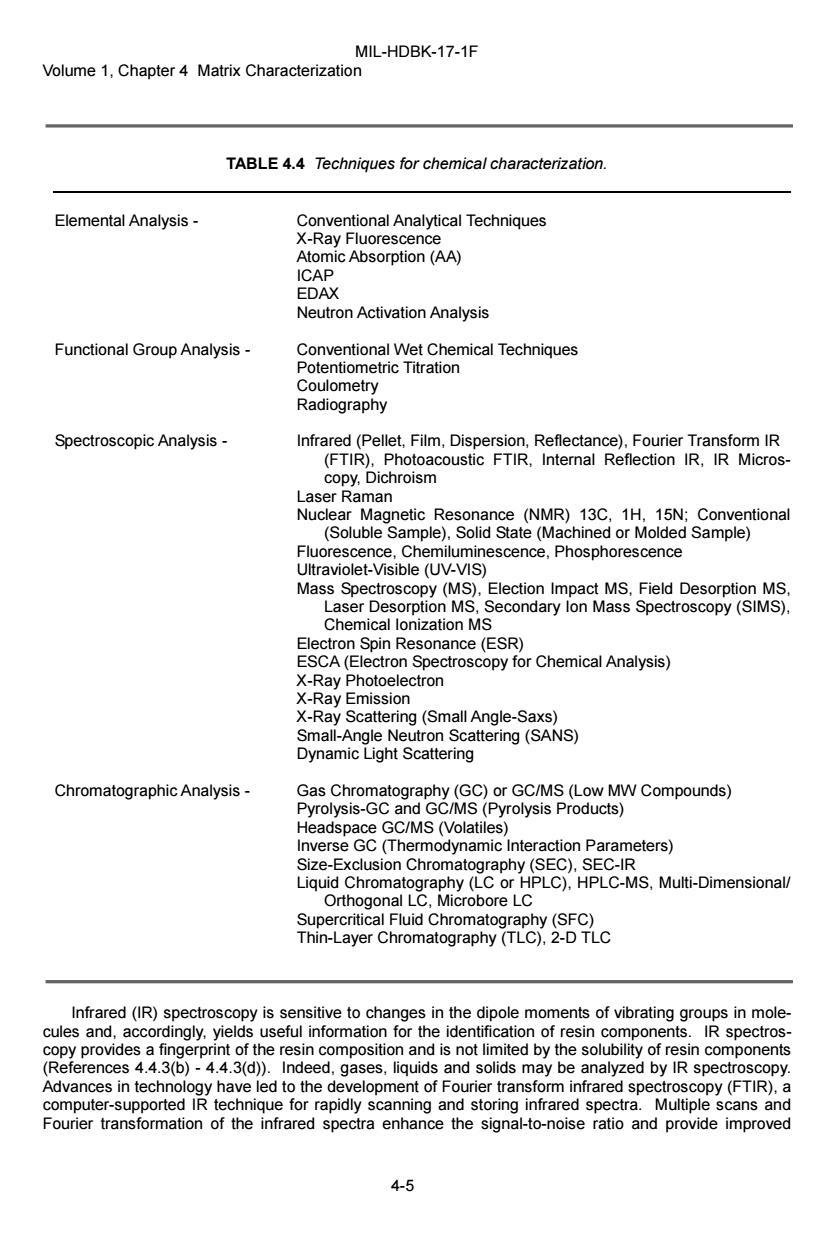正在加载图片...

MIL-HDBK-17-1F Volume 1,Chapter 4 Matrix Characterization TABLE 4.4 Techniques for chemical characterization. Elemental Analysis- Conventional Analytical Techniques X-Ray Fluorescence Atomic Absorption(AA) ICAP EDAX Neutron Activation Analysis Functional Group Analysis- Conventional Wet Chemical Techniques Potentiometric Titration Coulometry Radiography Spectroscopic Analysis- Infrared(Pellet,Film,Dispersion,Reflectance),Fourier Transform IR (FTIR),Photoacoustic FTIR,Internal Reflection IR,IR Micros- copy,Dichroism Laser Raman Nuclear Magnetic Resonance (NMR)13C,1H,15N;Conventional (Soluble Sample).Solid State (Machined or Molded Sample) Fluorescence,Chemiluminescence,Phosphorescence Ultraviolet-Visible (UV-VIS) Mass Spectroscopy(MS),Election Impact MS,Field Desorption MS. Laser Desorption MS,Secondary lon Mass Spectroscopy(SIMS). Chemical lonization MS Electron Spin Resonance(ESR) ESCA(Electron Spectroscopy for Chemical Analysis) X-Ray Photoelectron X-Ray Emission X-Ray Scattering(Small Angle-Saxs) Small-Angle Neutron Scattering(SANS) Dynamic Light Scattering Chromatographic Analysis- Gas Chromatography(GC)or GC/MS(Low MW Compounds) Pyrolysis-GC and GC/MS(Pyrolysis Products) Headspace GC/MS (Volatiles) Inverse GC (Thermodynamic Interaction Parameters) Size-Exclusion Chromatography(SEC),SEC-IR Liquid Chromatography (LC or HPLC),HPLC-MS,Multi-Dimensional/ Orthogonal LC,Microbore LC Supercritical Fluid Chromatography(SFC) Thin-Layer Chromatography(TLC),2-D TLC Infrared(IR)spectroscopy is sensitive to changes in the dipole moments of vibrating groups in mole- cules and,accordingly,yields useful information for the identification of resin components.IR spectros- copy provides a fingerprint of the resin composition and is not limited by the solubility of resin components (References 4.4.3(b)-4.4.3(d)).Indeed,gases,liquids and solids may be analyzed by IR spectroscopy. Advances in technology have led to the development of Fourier transform infrared spectroscopy(FTIR),a computer-supported IR technique for rapidly scanning and storing infrared spectra.Multiple scans and Fourier transformation of the infrared spectra enhance the signal-to-noise ratio and provide improved 4-5MIL-HDBK-17-1F Volume 1, Chapter 4 Matrix Characterization 4-5 TABLE 4.4 Techniques for chemical characterization. Elemental Analysis - Conventional Analytical Techniques X-Ray Fluorescence Atomic Absorption (AA) ICAP EDAX Neutron Activation Analysis Functional Group Analysis - Conventional Wet Chemical Techniques Potentiometric Titration Coulometry Radiography Spectroscopic Analysis - Infrared (Pellet, Film, Dispersion, Reflectance), Fourier Transform IR (FTIR), Photoacoustic FTIR, Internal Reflection IR, IR Microscopy, Dichroism Laser Raman Nuclear Magnetic Resonance (NMR) 13C, 1H, 15N; Conventional (Soluble Sample), Solid State (Machined or Molded Sample) Fluorescence, Chemiluminescence, Phosphorescence Ultraviolet-Visible (UV-VIS) Mass Spectroscopy (MS), Election Impact MS, Field Desorption MS, Laser Desorption MS, Secondary Ion Mass Spectroscopy (SIMS), Chemical Ionization MS Electron Spin Resonance (ESR) ESCA (Electron Spectroscopy for Chemical Analysis) X-Ray Photoelectron X-Ray Emission X-Ray Scattering (Small Angle-Saxs) Small-Angle Neutron Scattering (SANS) Dynamic Light Scattering Chromatographic Analysis - Gas Chromatography (GC) or GC/MS (Low MW Compounds) Pyrolysis-GC and GC/MS (Pyrolysis Products) Headspace GC/MS (Volatiles) Inverse GC (Thermodynamic Interaction Parameters) Size-Exclusion Chromatography (SEC), SEC-IR Liquid Chromatography (LC or HPLC), HPLC-MS, Multi-Dimensional/ Orthogonal LC, Microbore LC Supercritical Fluid Chromatography (SFC) Thin-Layer Chromatography (TLC), 2-D TLC Infrared (IR) spectroscopy is sensitive to changes in the dipole moments of vibrating groups in molecules and, accordingly, yields useful information for the identification of resin components. IR spectroscopy provides a fingerprint of the resin composition and is not limited by the solubility of resin components (References 4.4.3(b) - 4.4.3(d)). Indeed, gases, liquids and solids may be analyzed by IR spectroscopy. Advances in technology have led to the development of Fourier transform infrared spectroscopy (FTIR), a computer-supported IR technique for rapidly scanning and storing infrared spectra. Multiple scans and Fourier transformation of the infrared spectra enhance the signal-to-noise ratio and provide improved